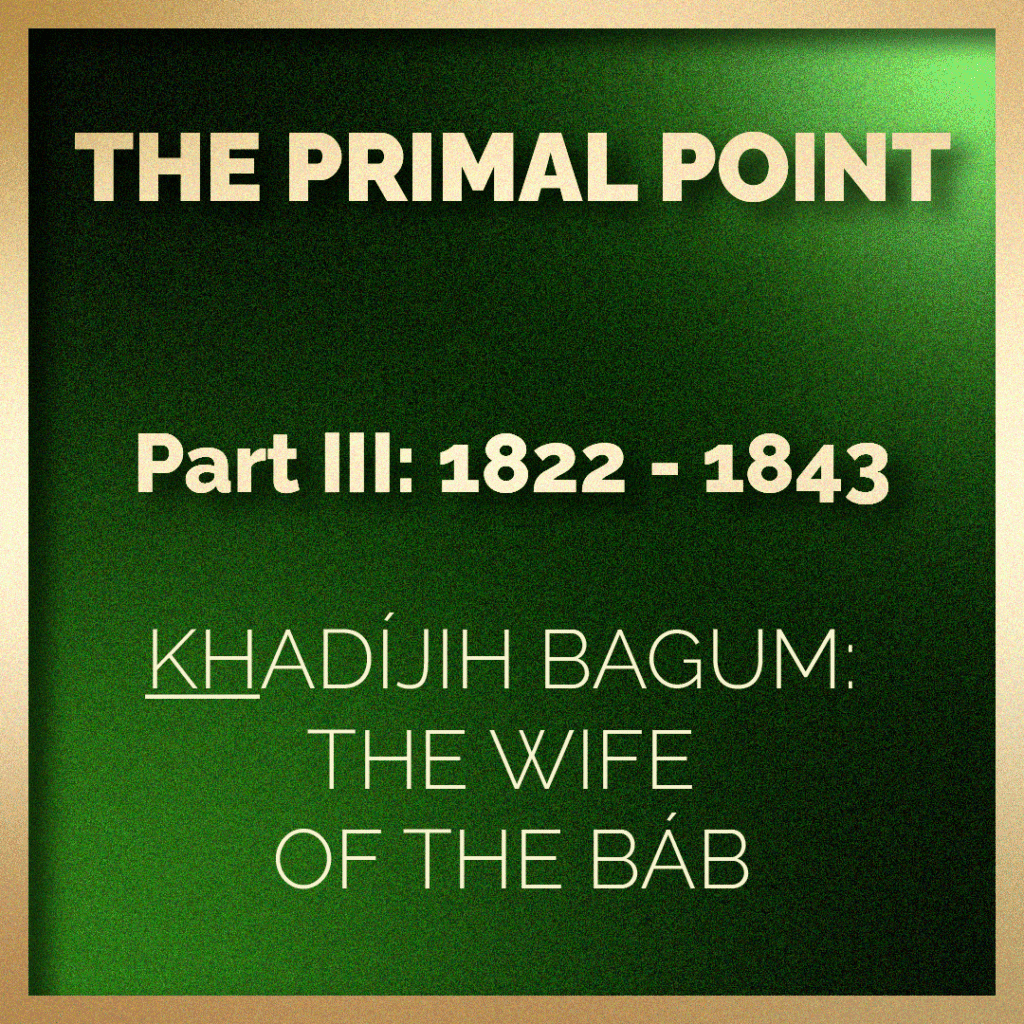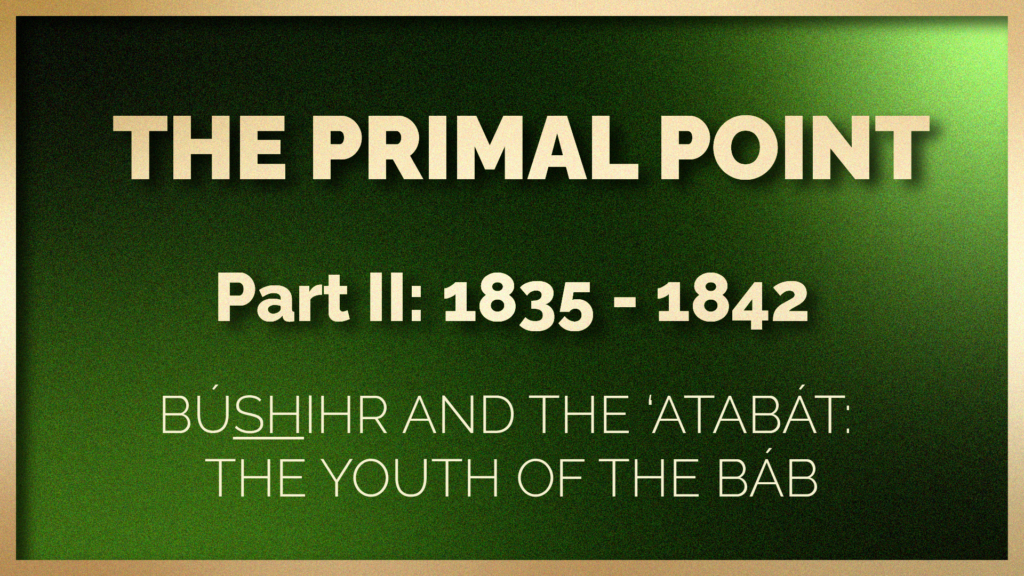
Written and illustrated by Violetta Zein
This part covers the life of the Báb from the age of 15/16 in 1835 to the age of 23 in 1842.
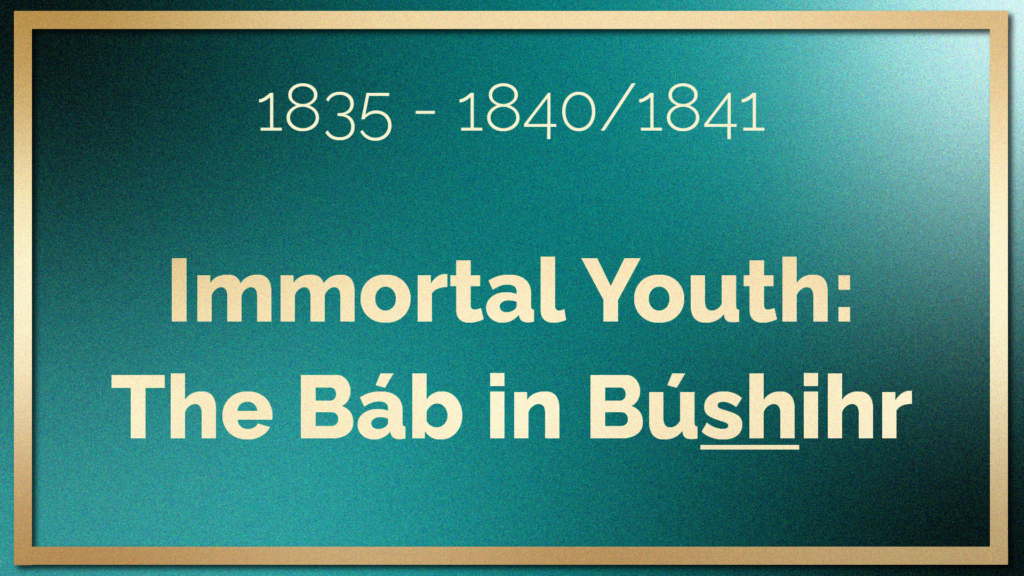

Map showing the distance between Shíráz and Búshihr. © Violetta Zein
In Búshihr, the Báb managed His family’s trading house, despite His young age. At first, the Báb was in partnership with His maternal uncle. The family offices were located in the Mínandí caravanserai, in Búshihr.
Ḥájí Mírzá Siyyid Muḥammad and his two younger brothers, Ḥájí Mírzá Siyyid ‘Alí and Ḥájí Mírzá Ḥasan ‘Alí, their relatives, and their children operated a family business of large-scale trade inside Persia from Shíráz, Búshihr, and Bandar-‘Abbás.
The Afnán family also traded internationally. They had a successful import and export business to and from Muscat and Bahrain in the Persian Gulf, ‘Ishqábád in Turkmenistan, Beirut, Lebanon, Zanzibar in East Africa, Bombay, Calcutta and Madras in India, and Hong Kong and Java in Southeast Asia. One of the Afnáns even moved to Bombay in the 1830s to facilitate trading to India.
According to the family archives, the Báb had commercial dealings in Yazd, Iṣfahán, Káshán, and Qazvín.
Commerce in the mid-19th century was an arduous business, filled with risk. Ships, constantly threatened by pirates and storms could sink, and camel caravans often fell prey to brigands and highwaymen.
The Báb lived in Búshihr for five years, from the age of 15 to 20, working as a merchant. He formed a commercial partnership with His uncle, Ḥájí Mírzá Siyyid Muḥammad for the first two years, but worked independently in His commercial transactions for the last three years of His stay in Búshihr.
The Báb gained wide notoriety throughout the region for His meticulous attention to detail, His uncompromising integrity and fairness in all His transactions, His godliness, devoutness, virtue, piety.
During this time, the Báb was also engaged in writing and composing, and the evidences of His sanctity as well as the wondrous verses which flowed from His pen attracted the envy and jealousy of learned men of Búshihr.
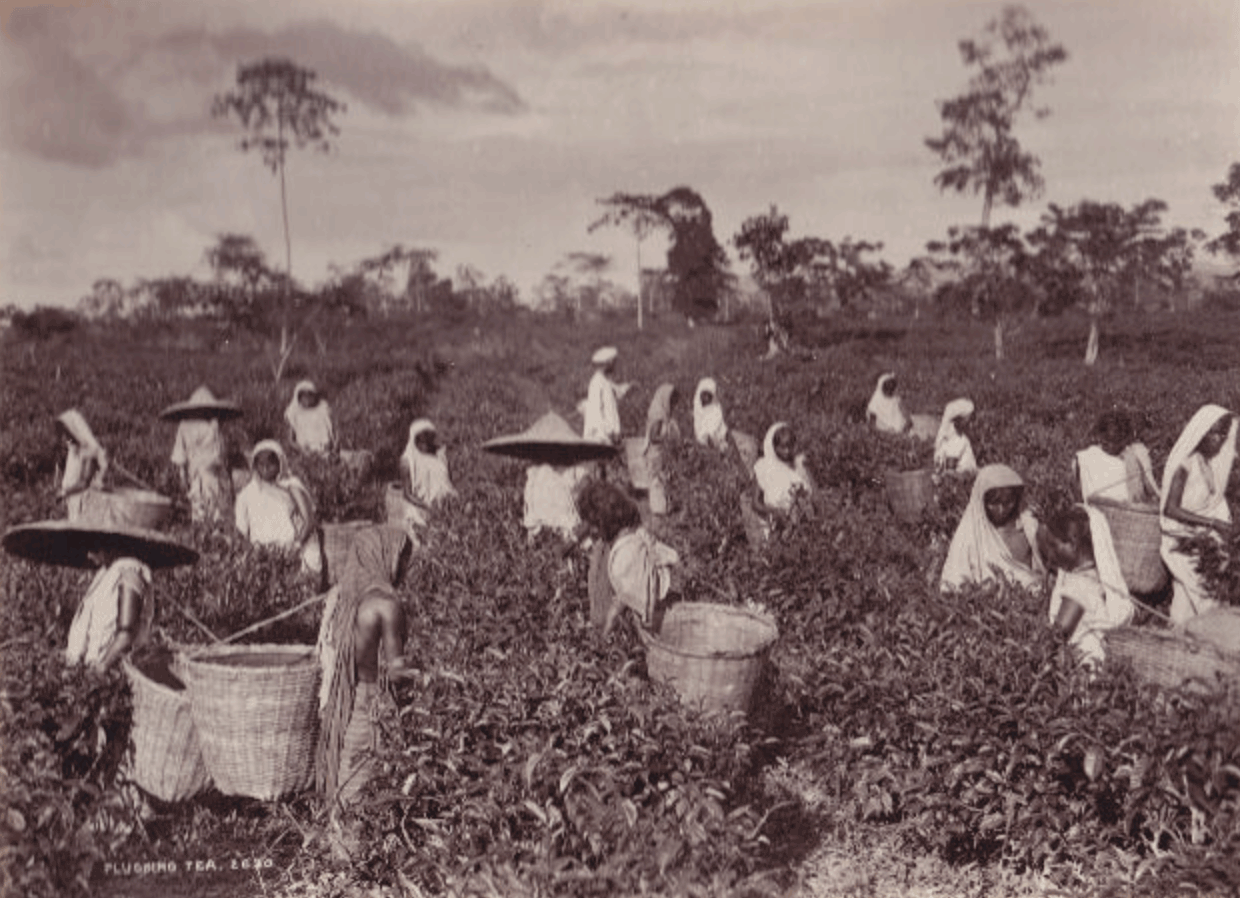
Workers plucking tea leaves in a plantation in India, one of the commodities imported by the Afnán family. Source: Wikimedia Commons.
We know from family business ledgers that the Báb and the Afnán family imported sugar, tea and coffee, grains, seeds and spices, indigo and other vegetable dyes and natural gums, as well as various kinds of calico used to make curtains, women’s clothing, tablecloths, English wool and cotton, raw silk, carpets, tin and other semi-processed metals, and sometimes livestock from India.
Their exports to India included carpets, dried rose petals, rosewater, foodstuffs, and dried fruits, such as shelled almonds and raisins, and at times gold coins.
It is interesting to note that there were certain goods the Báb did not trade.
There are no references in any of the surviving family business records that the Báb never bought or sold weapons, alcohol, or opium.
The Báb went even refrained from dealing in malodourous merchandise such as sheepskin and asafoetida—a gum made from a variety of giant fennel, which naturally has a strong and pungent smell, akin to rotting garlic.
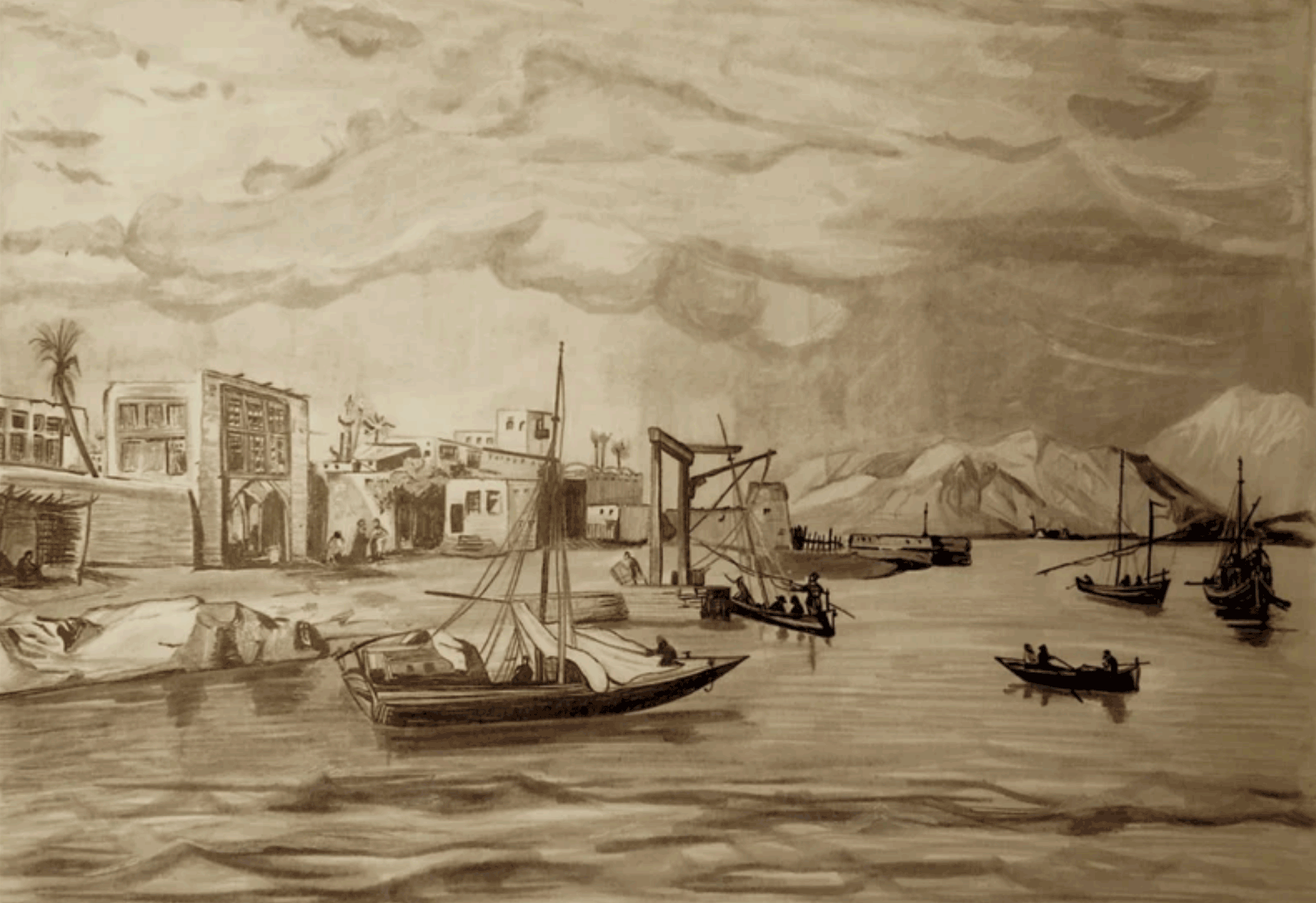
Old Persian vessels in the port of Búshihr, from A Most Dramatic Chapter in the Spiritual History of Humankind: A Pictorial Essay by Julio Savi published in Bahá'í World 2020-05.
On one occasion, Ḥájí Mírzá Abu’l-Ḥasan Yazdí, a Búshihr merchant, entrusted the Báb with merchandise to be sold while he left the city to go on pilgrimage to Mecca and Medina.
In his absence, the price of the merchandise fell, and the Báb had to sell it at a lower price than His client had expected.
Several months later when he returned, Ḥájí Mírzá Abu’l-Ḥasan was surprised to find that the Báb gave him 175 tumans more than he had expected.
When he asked the Báb about it, the Báb explained that if He had sold the merchandise when it was entrusted to him, that was the price it would have fetched, and he had compensated His client from His own money:
“What I have sent you is entirely your due. There is not a single farthing in excess of what is your right. there was a time when the trust you had delivered to Me had attained this value. Failing to sell it at that price, I now feel it My duty to offer you the whole of that sum.”
The Báb’s client insisted and entreated Him to accept the excess amount above what they had agreed upon, but the Báb would not hear of it, and refused to accept the money.
During the five years in which the Báb engaged in commerce in Búshihr, He mingled and associated with people of all walks of life, from the ‘ulamá, to merchants and shopkeepers and dealt with one and all in such a way that in every gathering and assembly people praised His splendid qualities.
The Báb’s trade accounts between 1835 and 1840 show that the family’s trade was mainly with the southern and central regions of Persia, and His notes regarding transactions with local merchants in Iṣfahán, Káshán, and Ṭihrán were imports of fabrics, tea, sugar, and spices in exchange for agricultural and food exports.
These accounts show the Báb was skilled in accounting and bookkeeping, and was deeply familiar with the merchant network of the south of Persia, and Búshihr in particular.
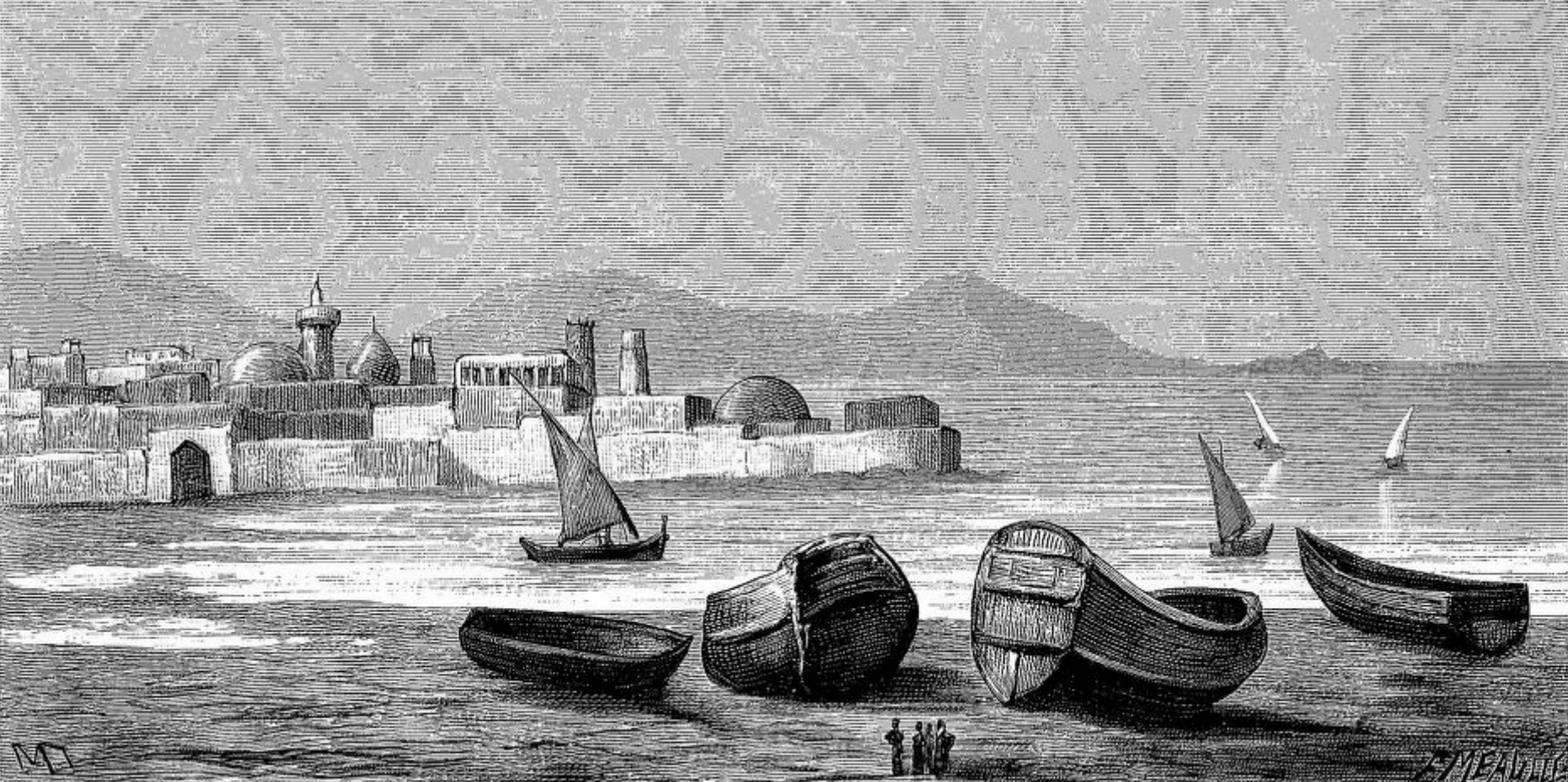
A view of Búshihr and the royal navy from Jane Dieulafoy, La Perse, la Chaldée et la Susiane, page 512. Source : Archive.org.
The hottest season of the year in Búshihr lasts about four months from May to October, with average daily high temperatures in August around 37°C (98°F).
During the years the Báb spent in Búshihr, the excessive, oppressive heat of the summer never stopped Him from devoting several hours to continuous prayer on the roof of His house, every Friday.
Although He was completely exposed to the scorching rays of the noonday sun, He turned His heart to God, ceaselessly communing with His Beloved, and entirely oblivious to the intensity of the heat or the world around Him.
From dawn to sunrise and from midday to late afternoon, the Báb dedicated His time to meditation and prayer.
Turning His gaze northwards to Ṭihrán, where Bahá'u'lláh was living, the Báb would greet the rising sun each day with a heart overflowing with love and joy.
To the Báb, the rising sun was the symbol of the Day-Star of Truth that would soon dawn on the world. He would look upon the rising orb with longing and steadfastness, as a lover beholding the face of His beloved.
In those moments of communion, the Báb seemed to be entrusting His message of love and yearning to His concealed Beloved, greeting the beaming rays with transports of delight.
The population of Búshihr who witnessed the Báb’s extraordinarily intense piety and devotion could not understand it. Faced with something they could not comprehend, they ignorantly decided that the Báb was enamored with the sun and that His mind had been damaged by exposing His uncovered head to its violent rays for so long.
The family of the Báb, tried to convince Him to take a greater interest in acquiring wealth and fame, but they soon realized that these things held no interest for Him.

“Limpid purity”: An abstract interpretation of spiritual purity. © Violetta Zein
The Báb always demonstrated such a pure character that even His enemies could never find fault in Him. Another characteristic of the Báb was that His spiritual qualities were manifested in His physical beauty.
His hair was jet black and His dark brown eyes shined like stars. His face was luminous, His features symmetrical, and He had a simple and humble, yet undeniably majestic bearing.
The Báb lived a pure and spotless life, devoted to loving and serving humanity. He not only reflected the light of the spirit but He radiated it to those who gravitated around Him.
The Báb’s spiritual qualities were universally acknowledged, and He was highly respected. When He entered a room, He was offered the seat of honor, and those present waited for Him to speak first.
His countenance was filled with happiness, resignation and contentment, and it seemed as if the very Spirit of God shined through Him.
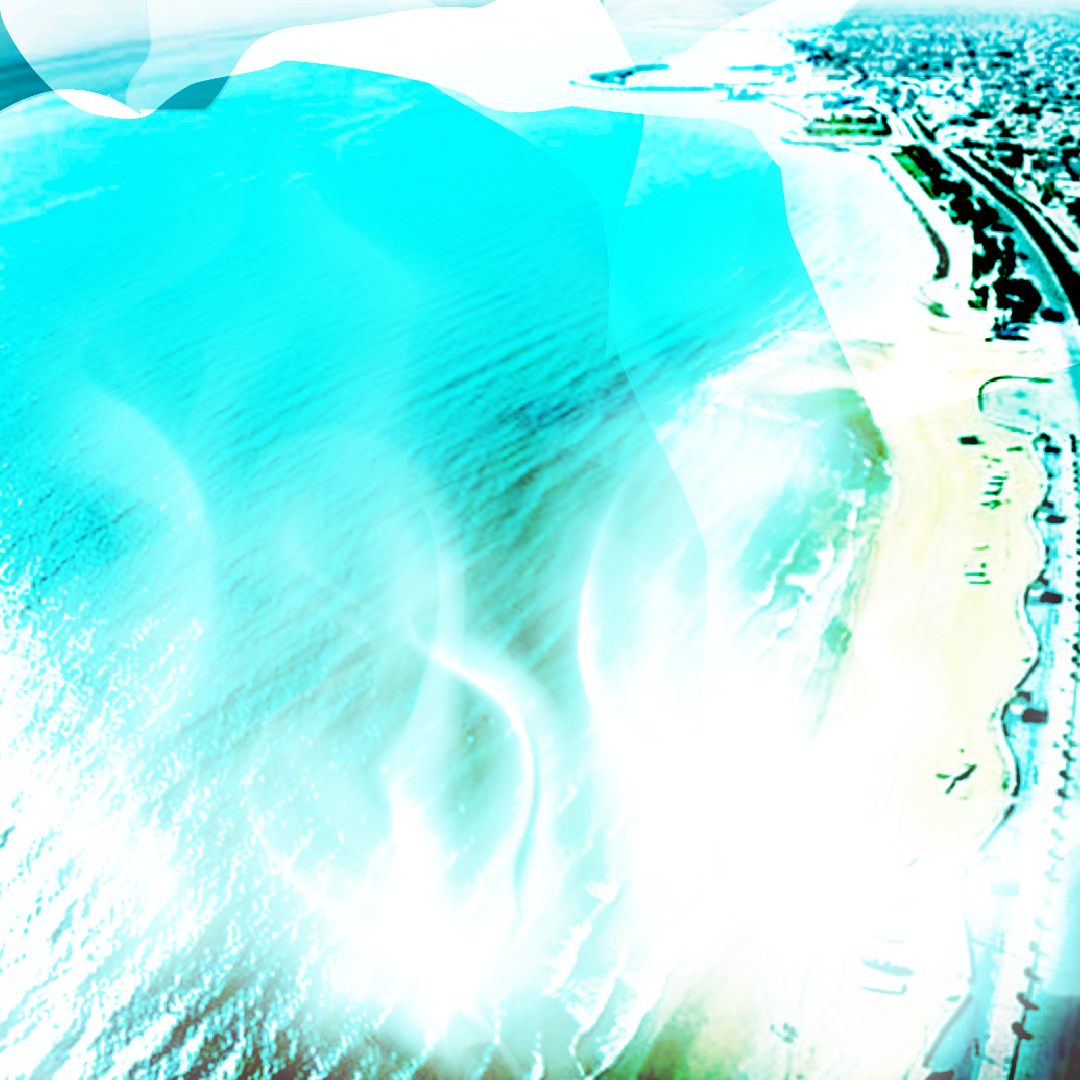
“Incandescent devotion”: An abstract interpretation of devotion to God, so incandescent it lights the world around it, on a background of the coastline of present-day Búshihr. © Violetta Zein
Siyyid Javád-i-Karbilá’í, who had been so impressed with the Báb when He had encountered Him as a child in Shíráz, traveled to Búshihr during the time the Báb was working there and met Him on several occasions during his stay there, on his way to India.
Every time Siyyid Javád saw the Báb, he found Him in an indescribable state of lowliness and humility, deeply courteous, His eyes downcast, and with such a serene expression on His face, that it made an indelible impression on His visitor.
The people who had contact with the Báb in Búshihr described Him as withdrawn and absorbed in prayer, simple of manner and gentle. These qualities, combined with His youth, attracted many people to Him and people began to praise His knowledge and eloquence.
Those who heard the Báb speak in Búshihr stated that He would stir their hearts to their very depths. Among the Báb’s favorite topics were stories of the Prophet Muḥammad, the Imáms and their holy companions, on which the Báb offered a refreshing, new perspective, which opened His audience’s mind.
During the years He lived in Búshihr, the Báb assiduously attended gatherings extolling the virtues of the Imám Ḥusayn, a subject that fascinated Him until the end of His life. He listened to the chanting of the eulogies with wrapt attention, tears streaming down His face, as His trembling lips murmured words of prayer and praise. His dignity and countenance moved and inspired those who witnessed His devotion at these events.

“Corrupt practices”: An abstract interpretation of old world values visibly crumbling, with the approach of a new Revelation from God. © Violetta Zein
'Abdu'l-Bahá stated that, in the course of His five years in Búshihr, the Báb “achieved extraordinary things and thoroughly demolished the foundation of people’s corrupt practices.”
There was a prevalent custom among merchants in Búshihr that after having concluded a deal, they would renege on the offer in order to renegotiate a better deal.
Following this dishonest practice, some merchants purchased a large quantity of indigo dye from the Báb, signed off on the deal, moved the dye to their offices, then returned to cancel the agreed-upon deal and haggle for a better deal.
The Báb refused to participate in the corrupt practice and said:
“You made a bargain, signed papers, and the transaction has been completed. I will not give a discount and will not renegotiate.”
When the merchants insisted, the Báb did not change His position:
“What I said is final.”
The merchants pleaded:
“It is the custom of the country.”
The Báb was unmoved:
“Many of these customs are wrong and will soon be abolished.”
No matter how much the dishonest merchants insisted, the Báb would not agree.
They were so obstinate that the Báb offered to take the merchandise back:
“[If] the price is high, return the merchandise as I will not barter.”
The merchants insisted three more times that it was the custom of the land, until finally, the Báb put a stop to the charade:
“I am ending this custom.”
The Báb ordered the indigo dye returned to His shop.
'Abdu'l-Bahá affirmed that, through His example and His unflinching integrity, the Báb changed many corrupt practices among the merchants of Búshihr during His five-year stay in the port city.
Shortly after the indigo dye incident, one of the Báb’s uncles arrived in Búshihr and the merchants who had failed to corrupt the Báb complained about his Nephew:
“He has ruined our reputation. We had a deal on dyes, however, as customary, we wished to renegotiate, but He did not comply. He arranged for the goods to be brought back from our store. This is a great insult to us as merchants. You should counsel Him not to repeat such offenses.”
The uncle spoke to the Báb about the incident:
“Why do You refuse to yield to people’s wishes and disrupt the established customs of the realm?”
The Báb refused to compromise:
“Even now, if they should wish to bargain after a transaction is completed, I would refuse again.”
‘Abdu’l-Bahá, after having recounted this story to Ḥájí Mírzá Ḥabibu'lláh Afnán did not stop smiling, and repeated several times:
“Prior to His declaration, the Báb announced that He would change many of the accepted ways.”

“He is celestial”: An abstract interpretation of the Báb’s divine nature, a celestial being walking on this earth among mere humans, created from the merging and superposition of three images of the heavens: NASA image 1 and NASA image 2 and Aurora lights by Tobias Bjørkli from Pexels.
Ḥájí Mírzá Siyyid Muḥammad, the Báb’s eldest uncle, sent a message through Siyyid Javád-i-Karbilá’í, who was traveling to Búshihr, to convince the Báb to not attract so much attention through His writings saying:
" Give some good counsel to my Nephew. Tell Him not to write or speak about certain studies that can only provoke the jealousy of certain people. These people cannot tolerate seeing a young merchant of little schooling demonstrate such scientific erudition and therefore become envious and resentful.”
The Báb’s uncle was insistent, but the wise Siyyid Javád simply replied with a verse of poetry:
“The luster of the fair of face cannot be veiled,
Shut him in and out of eyelet will he show his visage.”
After years of observing the Báb since His early childhood, Siyyid Javád, knew Him well, and held the Báb in high esteem. He told Ḥájí Mírzá Siyyid Muḥammad:
“We are earthbound and He is celestial. Our counsel is no use to Him.”
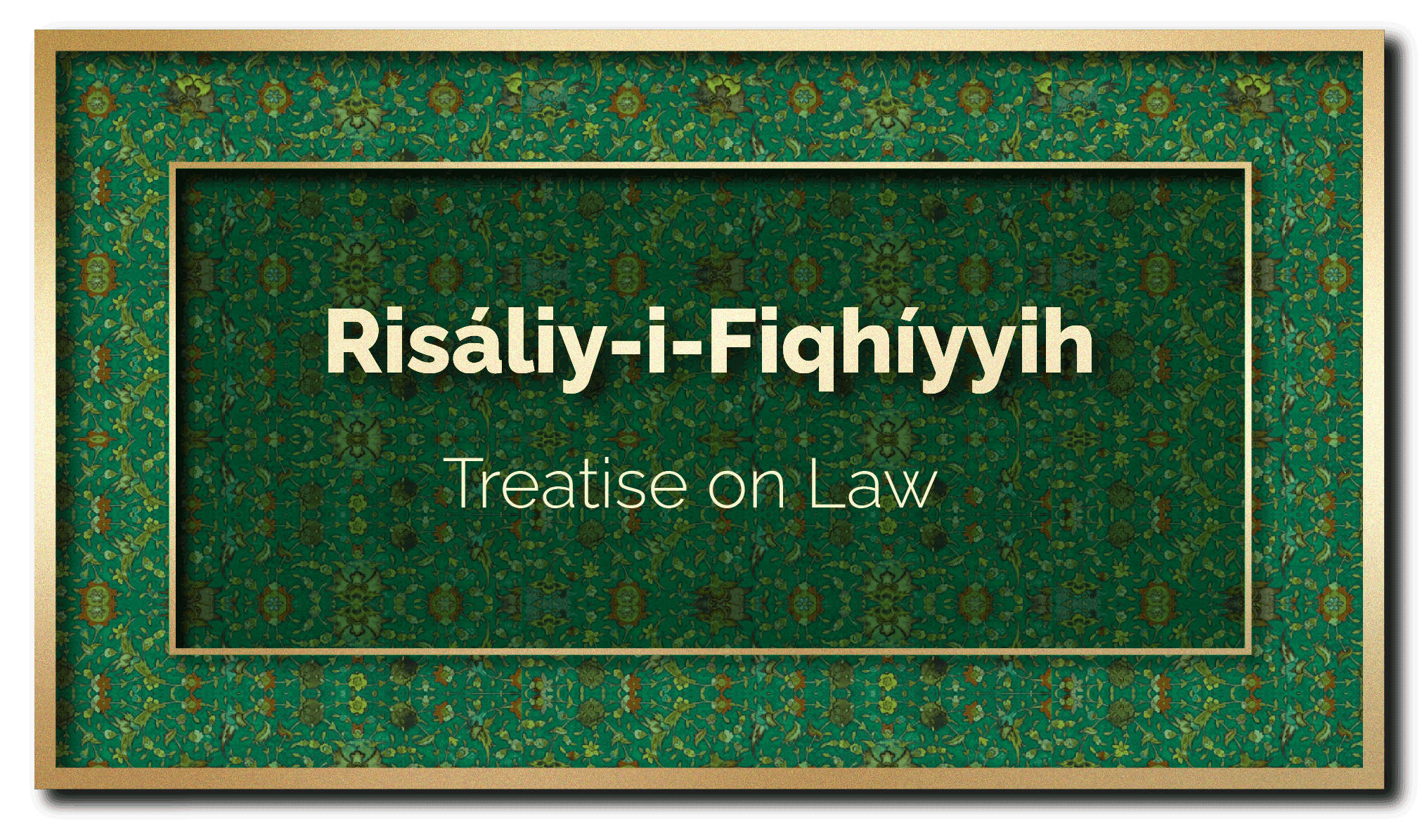
One of the writings of the Báb during this early period of His life is the Risáliy-i-Fiqhíyyih (Treatise on Law), which has regrettably not survived.
According to eminent orientalist A.L.M. Nicolas, this treatise of the Báb demonstrated a “true piety and a knowledge of things Islamic which seemed to point towards a brilliant future in the ranks of Shí'í orthodoxy.”
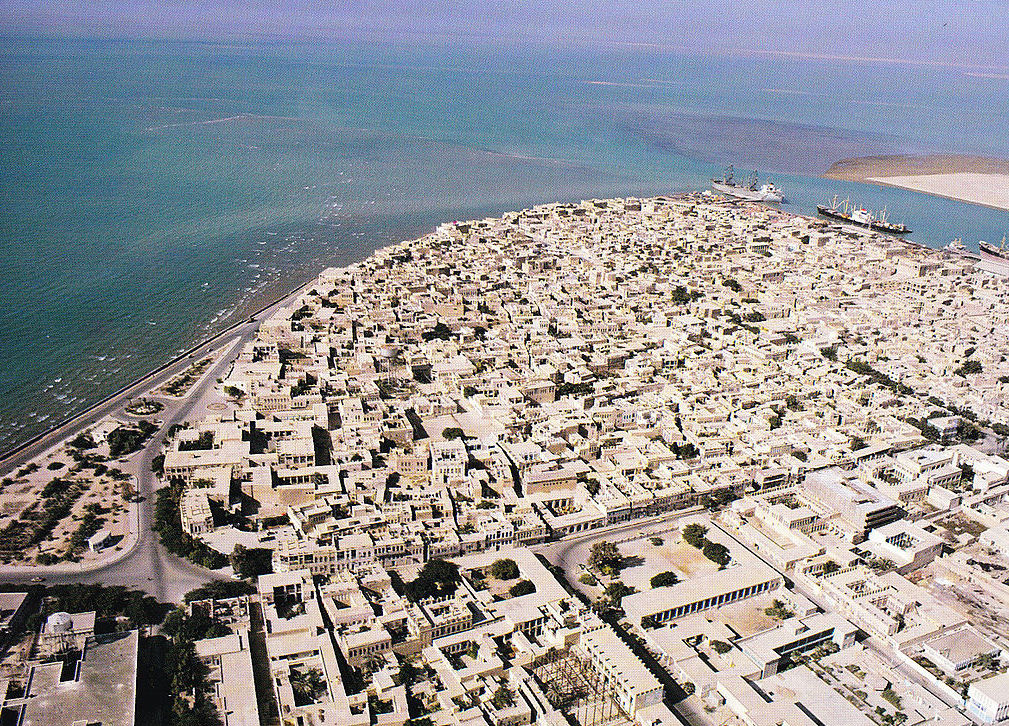
A 1973 aerial photograph of Búshihr, port city on the Persian Gulf, from where the Báb sailed to 'Iráq. Source: Wikimedia Commons.
A word of context before the story resumes. The ‘Atabát, or Atabát ‘Alíyat, literally “Supreme Shrines,” is a general term referring to the region of eastern 'Iráq the holy cities of Najaf, Karbilá, Káẓímayn, and Sámarrá are located.
In this region are six of the holiest Shrines of Shí’ah Islám:
- The Shrine of the First Imám, Imám ‘Alí, in Najaf;
- The Shrine of the Third Imám, Imám Ḥusayn, in Karbilá;
- The twin Shrines of the Seventh and Ninth Imáms in Káẓímayn;
- The Shrines of the Tenth and Eleventh Imáms in Sámarrá.
For someone to visit or perform the ‘Atabát means performing a Shí’ah rite of pilgrimage to all or some of these holy cities and Shrines.
After five years in Búshihr, the Báb wrote several letters to His uncles saying:
“I plan to visit the ‘Atabát. One of you should come to Búshihr and take over the business so I can commence my journey to the ‘Atabát.”
The uncles procrastinated and did not comply immediately with the Báb’s stated wish. When it was finally time for Him to leave, the Báb settled His accounts with everyone, prepared a detailed ledger, sealed the books, and left them in the office. He then sealed the entrance to the office and entrusted the key to the custodian of that building with the instructions to give the key to whichever of His maternal uncles should arrive first from Shíráz.
After this, the Báb wrote to His uncles in Shíráz, laying out the steps He had taken to secure the affairs of the business, and left for the ‘Atabát.
When the latest letter form the Báb reached His uncles, Ḥájí Mírzá Siyyid Muḥammad became anxious and worried that their name would suffer because their business had been left untended, but the Báb’s devoted uncle Ḥájí Mírzá Siyyid ‘Alí knew with full confidence that nothing would damage their business because their Nephew was above reproach.
Ḥájí Mírzá Siyyid ‘Alí told his brothers:
“Rest assured! I know Him, and our Nephew does not do anything wrong. [I am certain that] He has arranged people’s accounts before leaving.”
Ḥájí Mírzá Siyyid Muḥammad left for Búshihr and obtained the key from the caravanserai’s custodian. He observed the seal on the door of the office, then opened it, and carefully examined the books. He soon realized that the accounts relating to every single one of their clients were accurate, and sent a glowing report back to his brothers in Shíráz, lavishing praise and gratitude on the Báb for His resourcefulness and meticulousness.
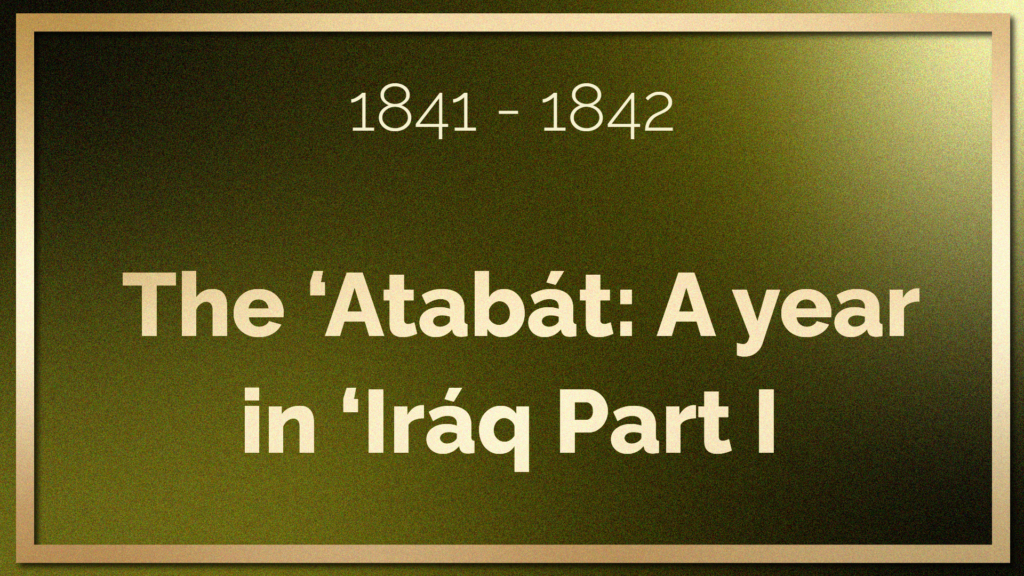
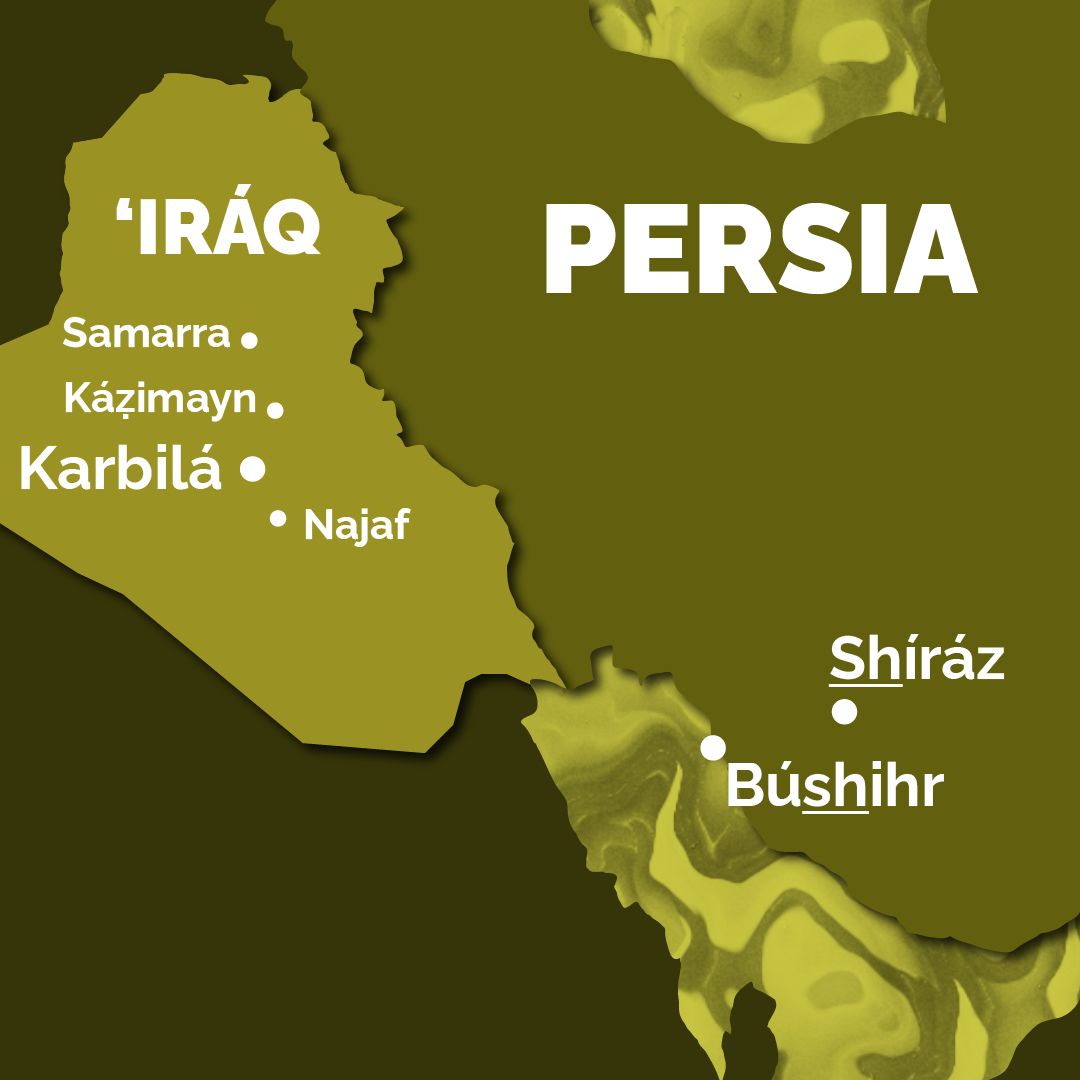
Map of the ‘Atabát, showing the four cities of pilgrimage, Najaf, Karbilá, Káẓimayn, and Samarra, in relationship to Persia and Shíráz, where the Báb was born and where He returned after His pilgrimage, and Búshihr, where He lived for five years before embarking on His ‘Atabát. The city of Karbilá is larger than the others because it is the only one we know He visited for certain for 8 months. © Violetta Zein
In 1841, the Báb left Búshihr to perform the complex rituals associated with the ‘Atabát. We do not know whether the Báb completed pilgrimage in all four of the holy cities, only that He spent 11 months in 'Iráq, 8 in Karbilá and 3 in various other places.
Every year, thousands of Shí’ah Muslims made their pilgrimage to the Shrine of Imám Ḥusayn, the martyred grandson of the Prophet Muḥammad, to read lengthy prayers at His Holy Tomb in the city of Karbilá.
When the Báb arrived in the Holy City for His pilgrimage, His deep devotion at the Shrine of Imám Ḥusayn deeply affected many of the pilgrims who saw Him.
As He prayed with His very characteristic devotion, the ardency of His prayers involuntarily attracted the attention of those around Him who interrupted their own prayers to turn all of their attention to the young Siyyid.
Although the prayers glorifying the Imám Ḥusayn were all beautiful, the Báb’s own prayers at the Shrine were sublime to those who heard them.
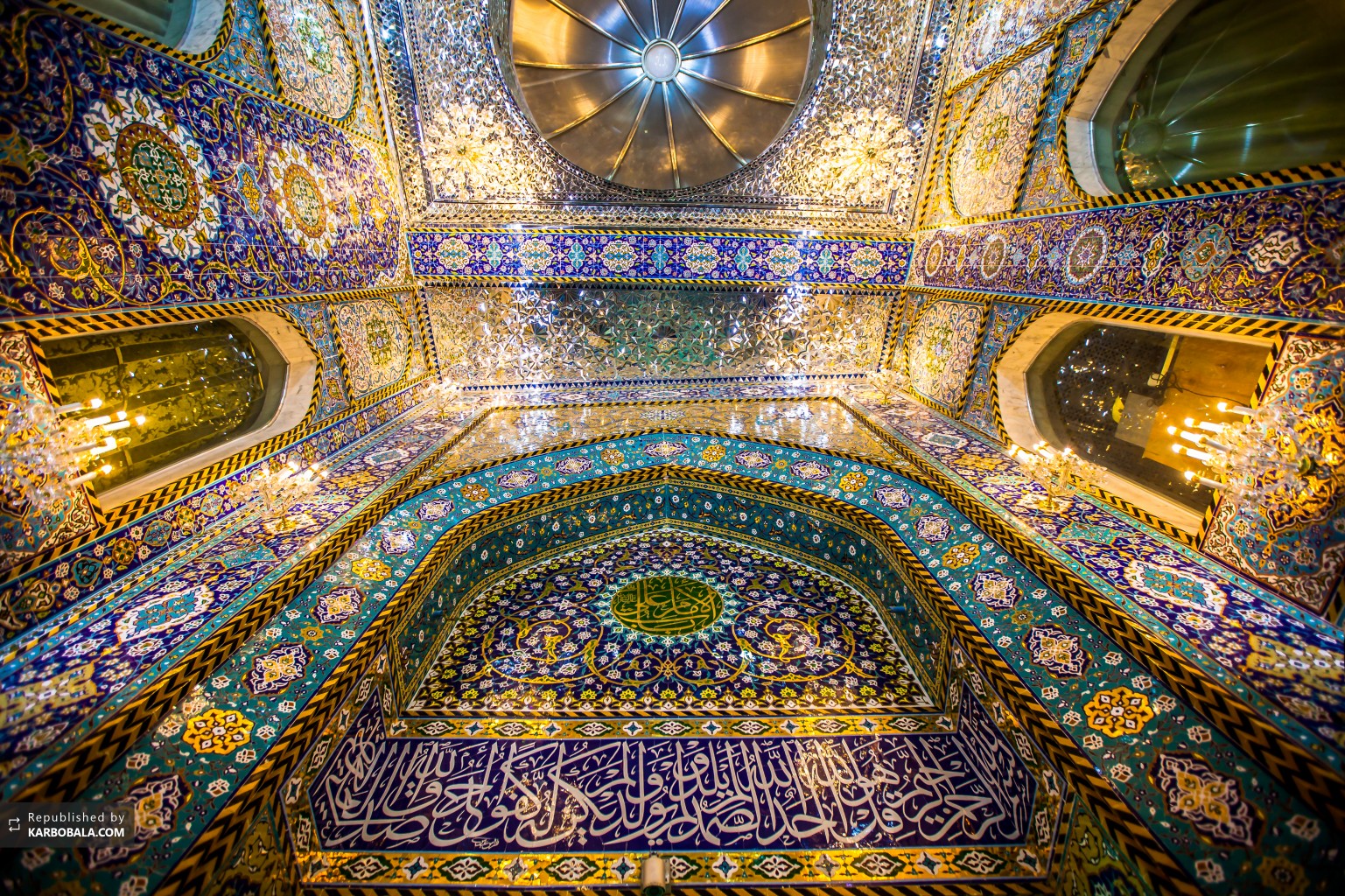
The intricate details of the inside of the Shine of Imám Ḥusayn in Karbilá where Mullá Sádiq met the Báb. Source: Wikimedia Commons.
The Báb remained in Karbilá for 8 months and many people were drawn to Him during this time because of His inspired utterances and the holiness of His life.
There are some reports, given the significant length of time the Báb spent in Karbilá, at a time when Mullá Ḥusayn, the future Letter of the Living, was also present in the holy city, that they met but did not speak. For the purposes of this chronology, the timeline of events adopted is the one supported by Shoghi Effendi and recounted by Nabíl in the Dawn-Breakers.
Mullá Ṣádiq, another of the Báb’s future disciples, vividly described his first impression of the 21-year old Báb:
"One day I entered into the mosque of the confessor of the Faith and I saw there a young man absorbed in profound meditation. His attitude was such, his piety so evident and so manifest, the tears which flowed from his eyes so sincere, that I felt myself invincibly attracted to him. Not wishing to interrupt him in his devotions, I seated myself in a corner and awaited the conclusion of his prayers. The more I looked at him, the more I was conquered by his noble air, his modest countenance and something I cannot describe that seemed to be emitted from his entire person.”
When the Báb finally left the Shrine, Mullá Ṣádiq followed Him, but the Báb would not respond to him until He had left the precinct of the mosque. He humbly and courteously asked Mullá Ṣádiq to forgive Him for not responding earlier as He considered the mosque precincts too sacred a place to think or speak of anything but God.
Mullá Ṣádiq, invited the Báb to his home that Friday to meet his teacher, Siyyid Káẓim-i-Rashtí. The Báb replied:
"What greater happiness and joy is his who takes his place at a gathering than to hear mentioned the most exalted light of God!”
Not only did the Báb accept Mullá Ṣádiq’s invitation, but He also met Siyyid Káẓim before that gathering.
We will look at both stories in detail, but first, at this juncture, we should pause and go back half a century to place the meeting between the Báb and Siyyid Káẓim in historical context.
Siyyid Káẓim was a Shaykhí, a disciple of Shaykh Aḥmad-i-Aḥsá’í, and both Shaykh Aḥmad and Siyyid Káẓim had been preparing the advent of the Promised One of Islám [the Báb] since 1793.
The meeting between the Báb and Siyyid Káẓim in Karbilá was a profoundly significant event for the Shaykhí teacher.
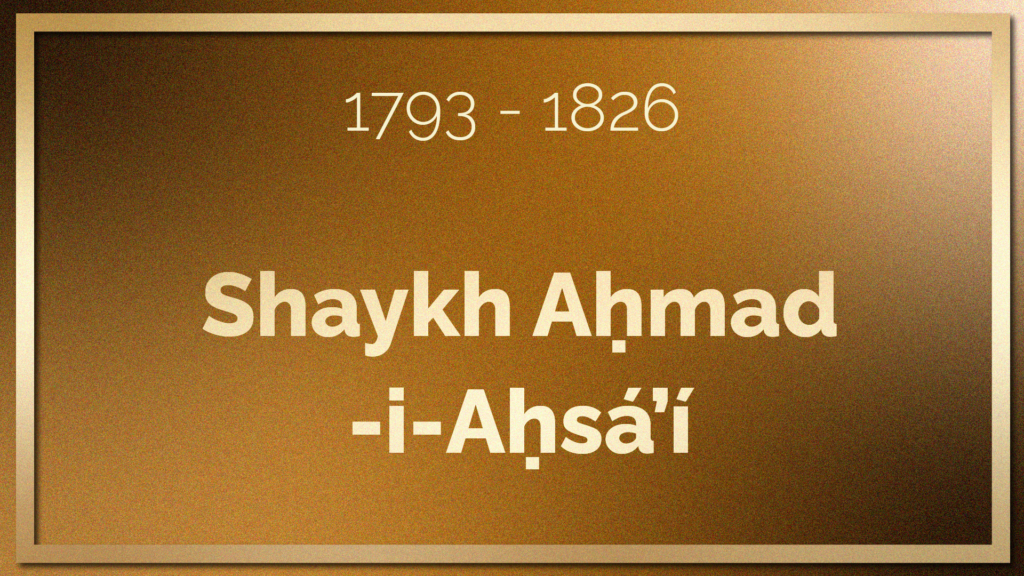
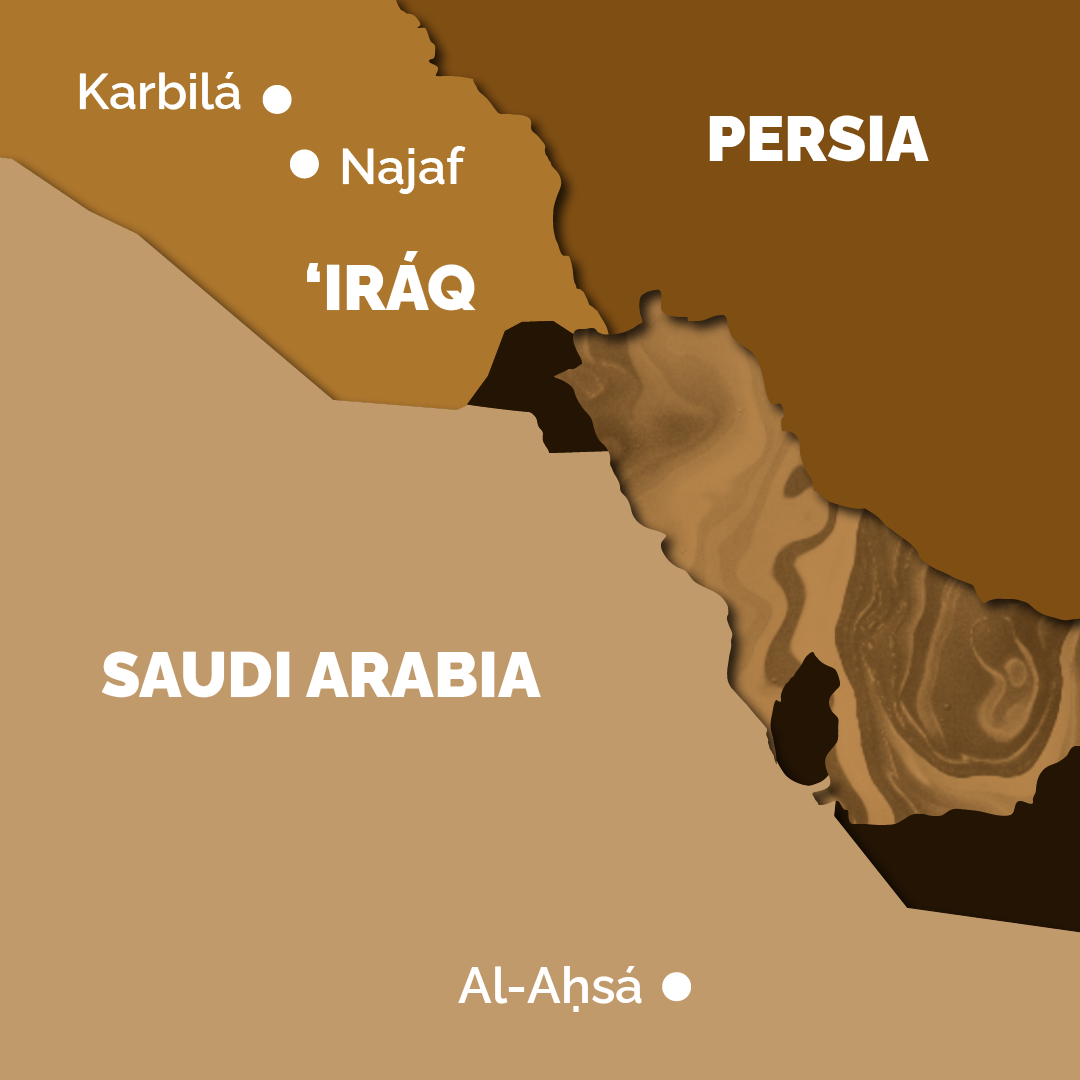
Map showing Al-Aḥsá in Saudi Arabia, where Shaykh Aḥmad was born, and Najaf and Karbilá in 'Iráq where he studied for years to become a mujtahid. © Violetta Zein
Shaykh Aḥmad-i-Aḥsá’í was born in 1753 in a town named Aḥsá’í, in the northeast of the Arabian peninsula. He belonged to the ancient tribe of Banú-Ṣakhr.
Shaykh Aḥmad was a visionary, described by 'Abdu'l-Bahá as a “resplendent star,” and by Shoghi Effendi as a “luminary,” as well as “the herald of the Bábí Dispensation.”
Looking at his beloved Shí’ah Faith, Shaykh Aḥmad observed its unity shattered, its strength sapped, its purpose perverted, and its Holy name degraded.
He felt a divine calling to regenerate the Faith, and at the age of 40 left for the Holy Cities of Najáf and Karbilá to receive formal theological training. Within a few years, Shaykh Aḥmad had attained the rank of mujtahid, and was highly respected for his superior learning and wisdom, guided the people to inner truths and meanings and expounded the secrets and mysteries of the Qur’án, and as he began to preach, a circle of earnest students gathered round him.
Shaykh Aḥmad’s constant themes were the near advent of the Deliverer of the Latter Days, promised to the world of Islám, who was the Promised Qá'im, hailing from the house of the Prophet Muḥammad, also known as the Mihdí.
Shaykh Aḥmad asked the Shí’ah divines of the holy cities of 'Iráq to grant him a license of mujtahid which would allow him to interpret religious law and formulate authoritative answers to legal questions.
Soon, Shaykh Aḥmad’s fame spread throughout 'Iráq and Persia. Some years later, after he felt he had achieved his purpose in 'Iráq, Shaykh Aḥmad was drawn to Persia and left without informing anyone of the divine intuition which was prompting this journey.
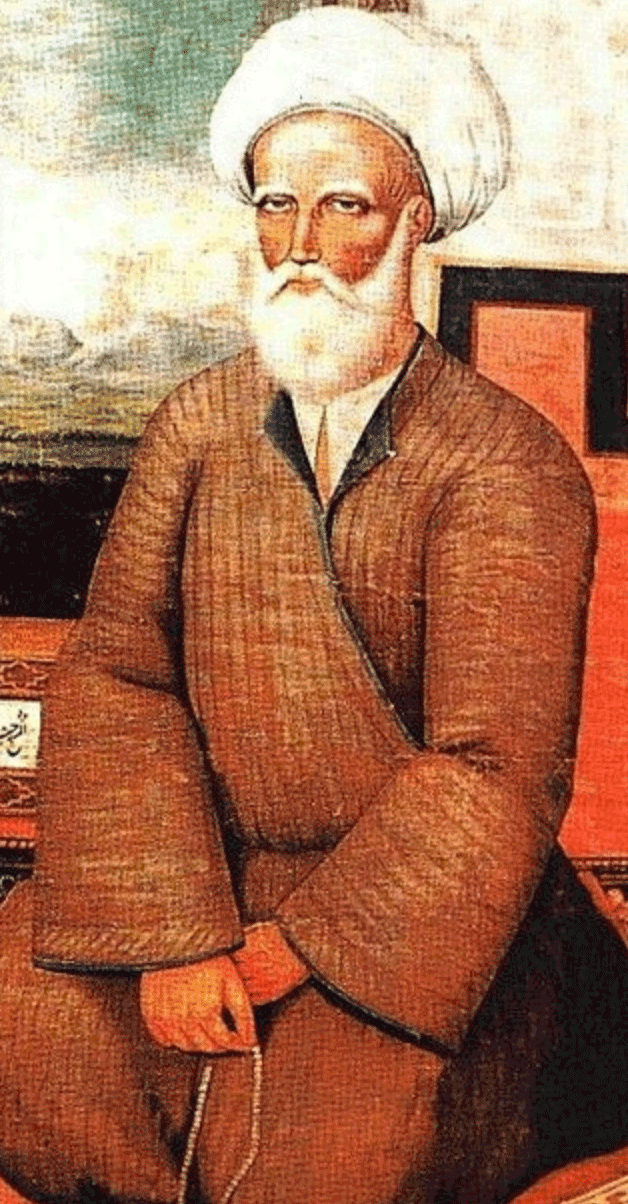
A 19th century colored anonymous portrait of Shaykh Aḥmad, the prominent 19th-century Shí’ah Muslim theologian and jurist who proclaimed the advent of the Promised One. Source: Wikimedia Commons.
Shaykh Aḥmad traveled to Persia around 1806 via Búshihr in the Persian Gulf, to outward appearances for the purpose of paying his respects at the shrine of the Imám Riḍá in Mashhad.
In reality, Shaykh Aḥmad knew, from having immersed himself in Shí’ah scripture and prophecies, that the promised Qa’im’s arrival was imminent, and the object of his journey to Persia was filled with eagerness to meet those to whom he could unburden his soul, and with whom he could share his glorious secret.
Shaykh Aḥmad visited Shíráz, the city where the Báb would be born in just a few years, and later, throughout his travels, extolled the city in passionate terms, lavishing so much praise on Shíráz that those who heard him were stunned.
Shaykh Aḥmad would say to them:
“Wonder not, for ere long the secret of my words will be made manifest to you. Among you there shall be a number who will live to behold the glory of a Day which the prophets of old have yearned to witness.”
Shaykh Aḥmad traveled to Yazd, a city wedged in between two deserts, where he spent the bulk of his eight years in Persia. It was during his stay in Yazd in 1815 - 1816, that he met a 20-year old disciple of his, Siyyid Káẓim-i-Rashtí, whom he immediately appointed his successor, despite the jealousy of his older students.
Shaykh Aḥmad welcomed Siyyid Káẓim with love and warmth:
“How eagerly have I waited for you to come and deliver me from the arrogance of this perverse people!”
Shaykh Aḥmad left Yazd to travel throughout the country, visiting Khurásán, Mashhad, Núr, Ṭihrán, Kirmansháh, all the while spreading the glad tidings of a new, imminent Revelation, to those who had a hearing ear, speaking momentous words:
“Ere long will the earth be turned into a paradise. Ere long will Persia be made the shrine round which will circle the peoples of the earth.”
Shaykh Aḥmad left astonishing prophecies about the births and Revelations of the Báb and Bahá'u'lláh.
In 1819, the year the Báb was born, Shaykh Aḥmad lost his son, whose name was Shaykh ‘Alí. To his disciples who mourned his loss he spoke these words of comfort:
“Grieve not, O my friends, for I have offered up my son, my own ‘Alí, as a sacrifice for the ‘Alí whose advent we all await. To this end have I reared and prepared him.”
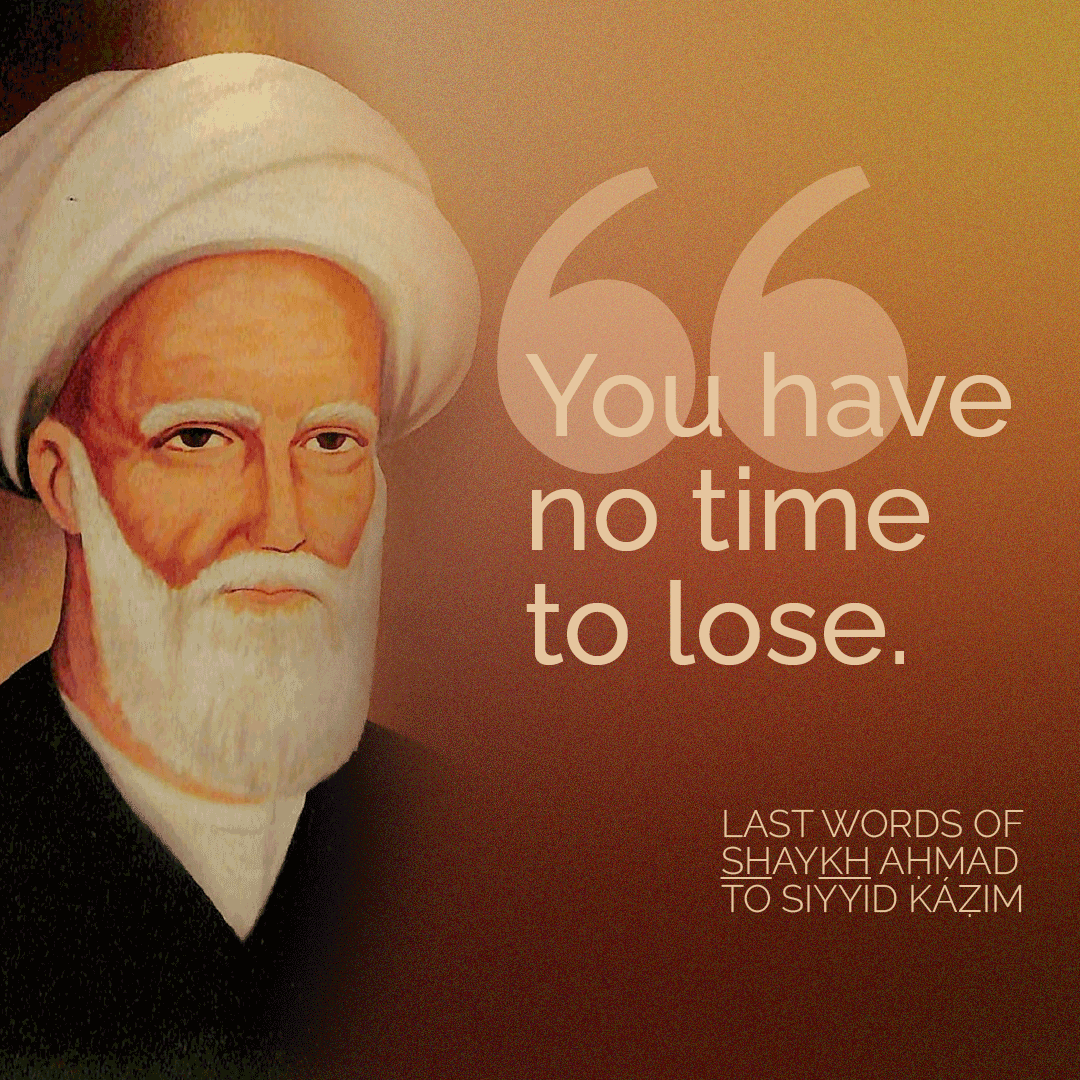
“Last words”: Decorated quote of Shaykh Aḥmad’s purported last words to Siyyid Káẓim. © Violetta Zein Portrait of Shaykh Aḥmad from 1910, unknown painter: Wikimedia Commons.
After 15 years in Persia, Shaykh Aḥmad returned to 'Iráq in 1821 with Siyyid Káẓim to continue his teaching and proclamation work.
A short time before his death in 1826, he left Karbilá for the last time and finally disclosed to Siyyid Káẓim, his chosen successor, the secret of his mission, leaving him with these powerful last words:
“You have no time to lose. Every fleeting hour should be fully and wisely utilised. You should gird up the loin of endeavour and strive day and night to rend asunder, by the grace of God and by the hand of wisdom and loving-kindness, those veils of heedlessness that have blinded the eyes of men. For verily I say, the Hour is drawing nigh, the Hour I have besought God to spare me from witnessing, for the earthquake of the Last Hour will be tremendous. You should pray to God to be spared the overpowering trials of that Day, for neither of us is capable of withstanding its sweeping force. Others, of greater endurance and power, have been destined to bear this stupendous weight, men whose hearts are sanctified from all earthly things, and whose strength is reinforced by the potency of His power.”
Shaykh Aḥmad died at the age of 81 in 1826, and is buried near the holy city of Medina, in the vicinity of the tomb of the Prophet Muḥammad.
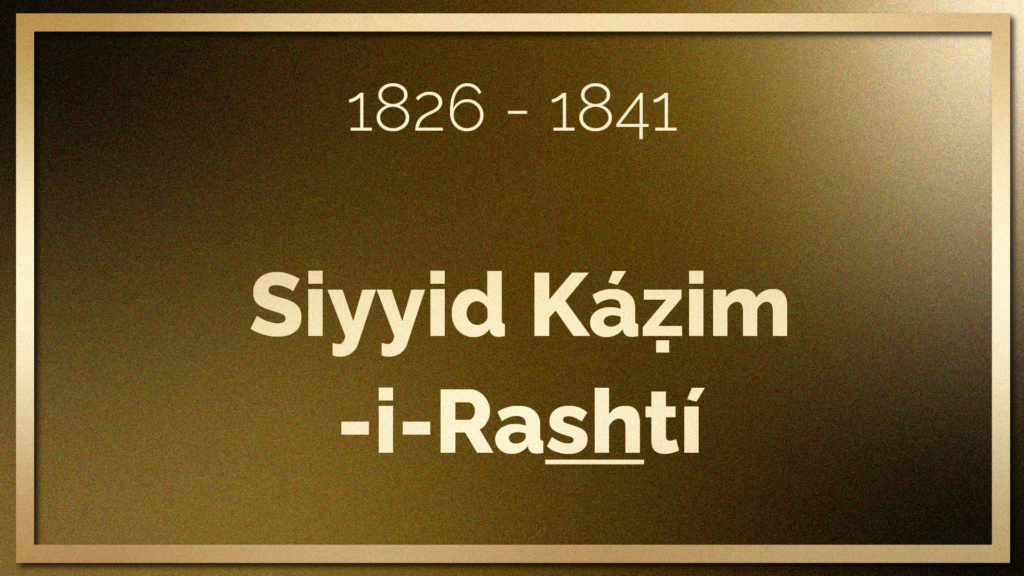
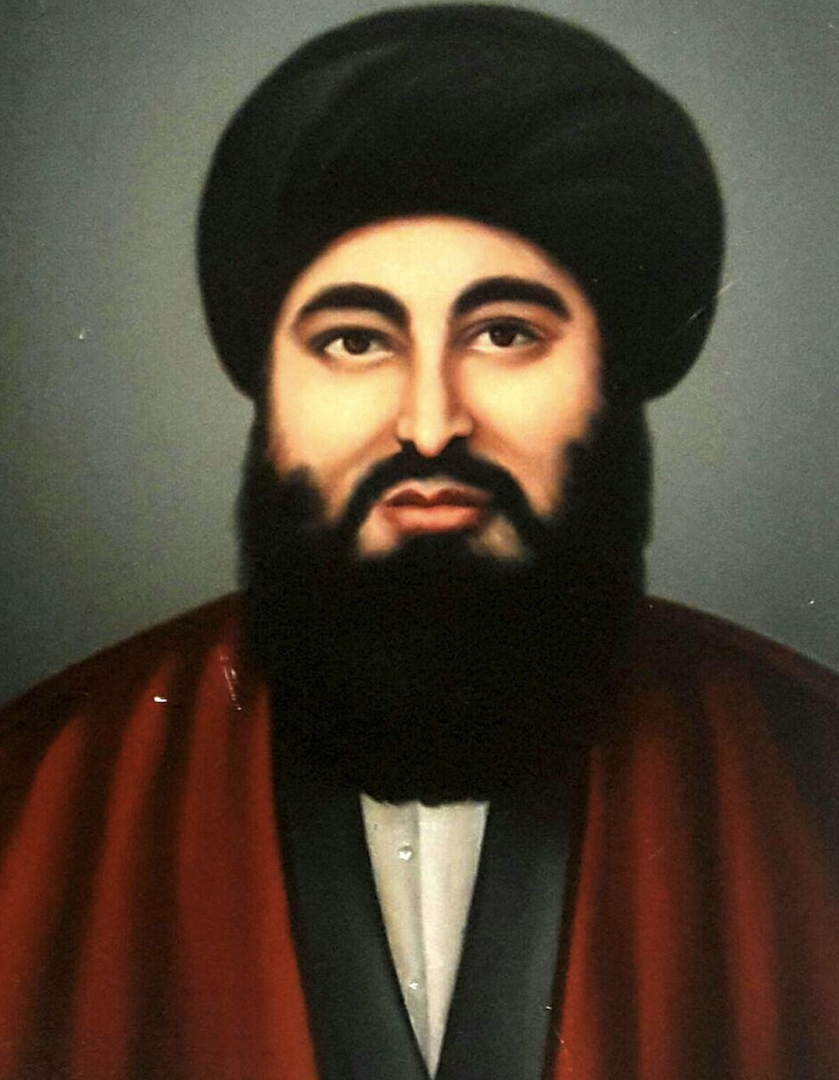
A 19th century anonymous portrait of Siyyid Káẓim. Source: Wikimedia Commons.
Siyyid Káẓim was 33 years old when he took over Shaykh Aḥmad’s school after his teacher’s death. He faced great opposition against his teachings and had to withstand constant intrigues and powerful enemies who attempted to undermine him at every turn, but he also gained devoted followers such as Mullá Ḥusayn-i-Bushrú’í, the one who was destined to witness the Revelation of the Báb.
For several years prior to the Báb’s arrival in Karbilá, Siyyid Káẓim, who could feel the approaching hour of the Promised One’s Declaration, had increasingly focused his discourse on the signs of the Qá’im’s manifestation, His character and appearance, repeating to his students:
“He is of noble lineage. He is a descendant of the Prophet of God, of the family of Háshim. He is young in age, and is possessed of innate knowledge. His learning is derived, not from the teachings of Shaykh Ahmad, but from God. My knowledge is but a drop compared with the immensity of His knowledge; my attainments a speck of dust in the face of the wonders of His grace and power. Nay, immeasurable is the difference. He is of medium height, abstains from smoking, and is of extreme devoutness and piety.”
The Báb arrived in Karbilá as a part of His ‘Átabát pilgrimage in 1841, and one morning after His arrival, Siyyid Káẓim, unwarned and unprompted, went to meet Him.
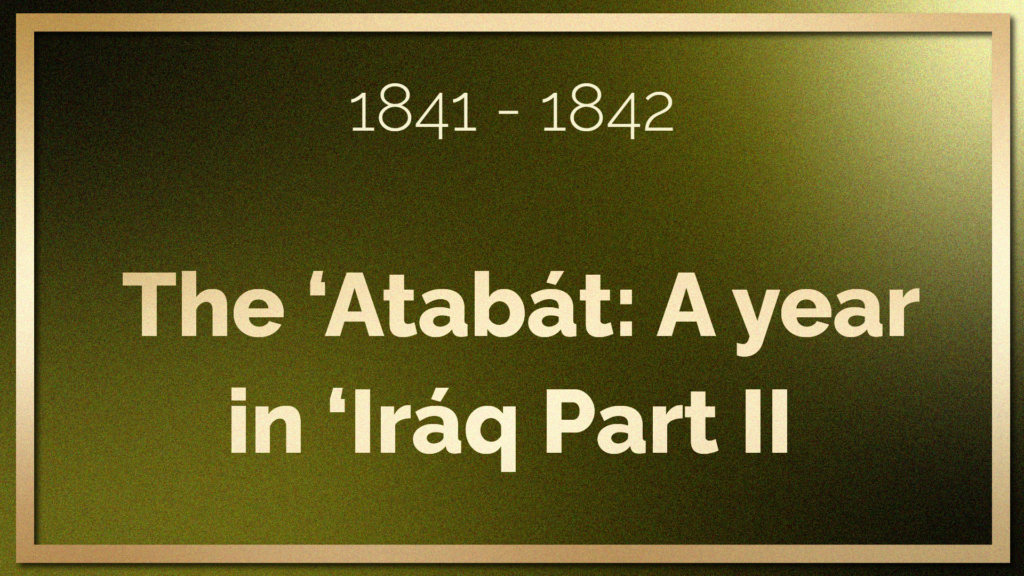
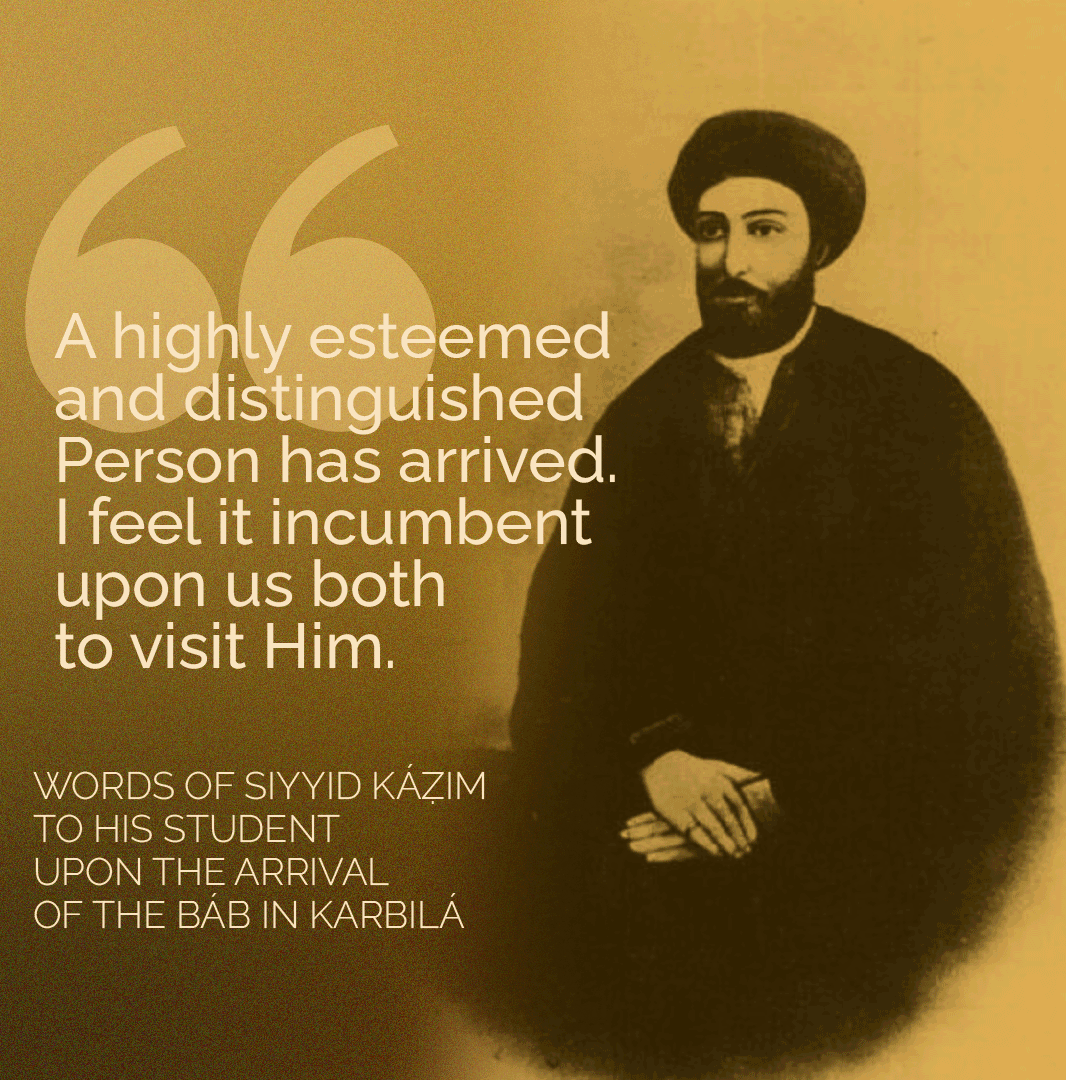
“The Visitor”: Decorated quote of the words of Siyyid Káẓim to his student regarding the Báb’s arrival in Karbilá. © Violetta Zein Portrait of Siyyid Káẓim from Mehrabkhani, Ruhu'llah (1987). Mulla Husayn: Disciple at Dawn, page 28, source: Wikimedia Commons.
That day in question, Siyyid Káẓim asked Shaykh Ḥasan-i-Zunúzí, one of his students—who would be a faithful disciple to the Báb until the very end—to accompany him:
“A highly esteemed and distinguished Person,’ he said, ‘has arrived. I feel it incumbent upon us both to visit Him.”
Morning light had just broken as the master and disciple made their way through the streets of Karbilá. They soon reached a house, and saw a Youth standing at the door, wearing a green turban, an indescribable expression of humility and kindliness on His face.
The Báb quietly approached Siyyid Káẓim and lovingly embraced him. Siyyid Káẓim expressed profound reverence towards the Youth, receiving His expressions of affection and respect speechlessly, with his head bowed.
The Báb led the two men to the upper floor of the house, into a room filled with flowers and a delightful scent, and He bade them be seated.
The Báb filled a silver cup to overflowing, and handed it to Siyyid Káẓim, saying:
“A drink of a pure beverage shall their Lord give them.”
This verse from the Qur’án were the only words spoken during this meeting.
Siyyid Káẓim took the cup with both hands and drank it, and soon after, the Báb rose from His seat and bade His guests farewell.
Shaykh Ḥasan-i-Zunúzí was speechless.
He could not stop thinking of his Siyyid Káẓim’s profound respect towards the Siyyid, of the Youth’s charming face, His dignity of bearing, the delicious smell of the beverage He had offered, and of the fact they had drank from a silver cup, the use of which was strictly prohibited by Islám.
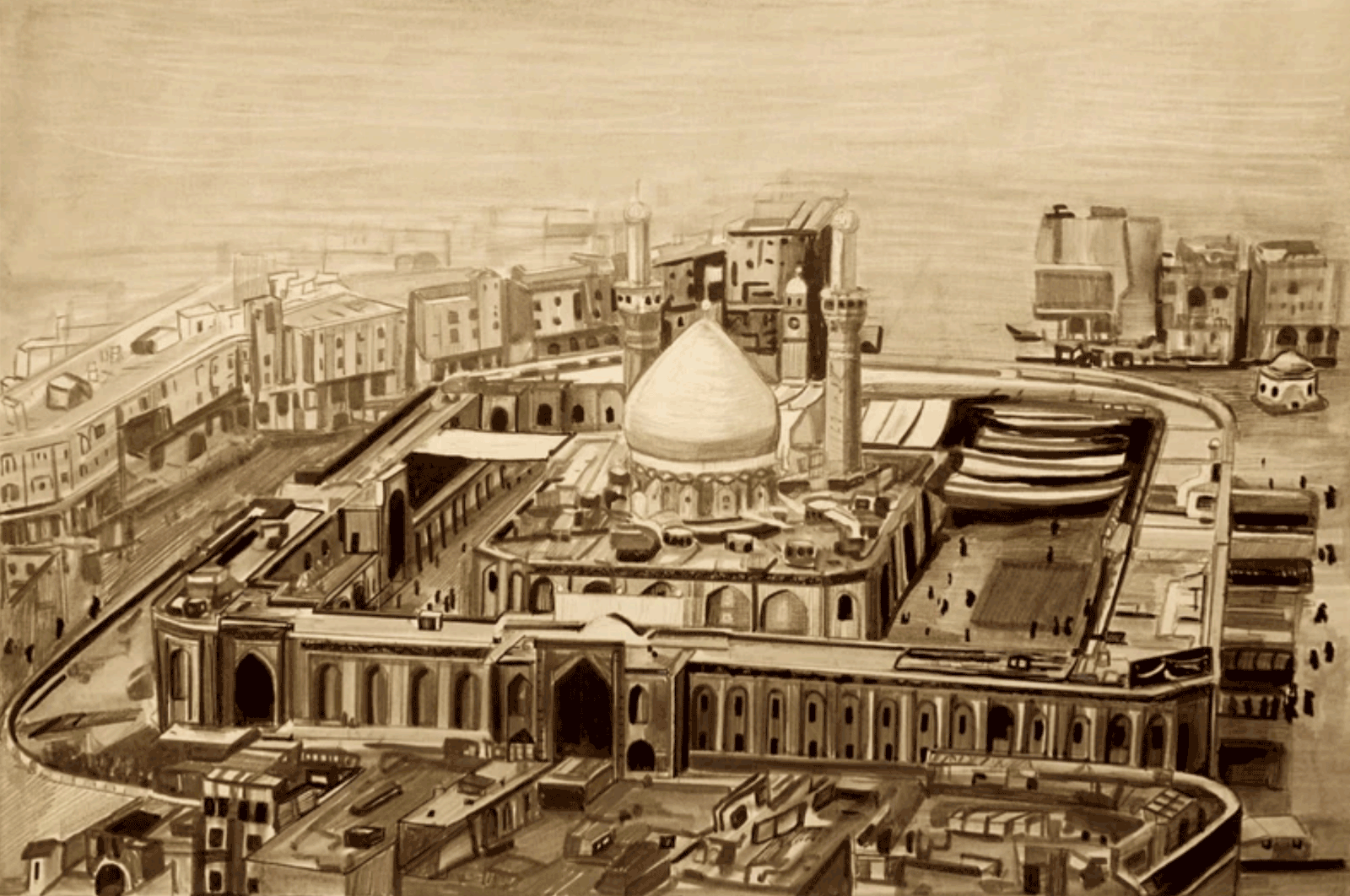
The shrine of the Imám Ḥusayn, the most venerated Muslim martyr in Karbilá. In the first half of the nineteenth century the Shaykhí school flourished in this religious center. This is where Shaykh Aḥmad and Siyyid Káẓim preached the imminent advent of the Promised One of Islám and prepared their pupils for that event. This school was attended by the first disciples of the Báb and many other prominent figures of Bábí history, and is probably where the Báb was present at a lecture by Siyyid Káẓim. Source: A Most Dramatic Chapter in the Spiritual History of Humankind: A Pictorial Essay by Julio Savi published in Bahá'í World 2020-05.
Three days later, the Báb responded to Mullá Ṣadiq’s invitation, a story which took place immediately before the vignettes about Shaykh Aḥmad and Siyyid Káẓim.
The Báb arrived at Siyyid Káẓim’s school on the appointed Friday, when the master was lecturing to his assembled students from the pulpit. It was a full house, and, finding no available seat, the Báb sat close to the entrance of the room, with His distinctive modesty.
As soon as his eyes fell upon the Báb, Siyyid Káẓim became completely silent.
Everyone present was astonished, and one of his students begged him to continue his unfinished argument, but Siyyid Káẓim responded:
“What more shall I say?”
Turning his face to the Báb, he said:
“Lo, the Truth is more manifest than the ray of light that has fallen upon that lap!”
At that very moment a ray of sunlight had fallen on the Báb’s lap.
The same student who had asked Siyyid Káẓim to continue his lecture asked why he never revealed the name or identity of the Promised One. Siyyid Káẓim pointed his finger to his throat, implying danger of death if he were to speak.
The students, as prophesied by Siyyid Káẓim himself, were not able to recognize the Promised One even when their teacher pointed to the ray of light on the Báb’s lap with his own finger.
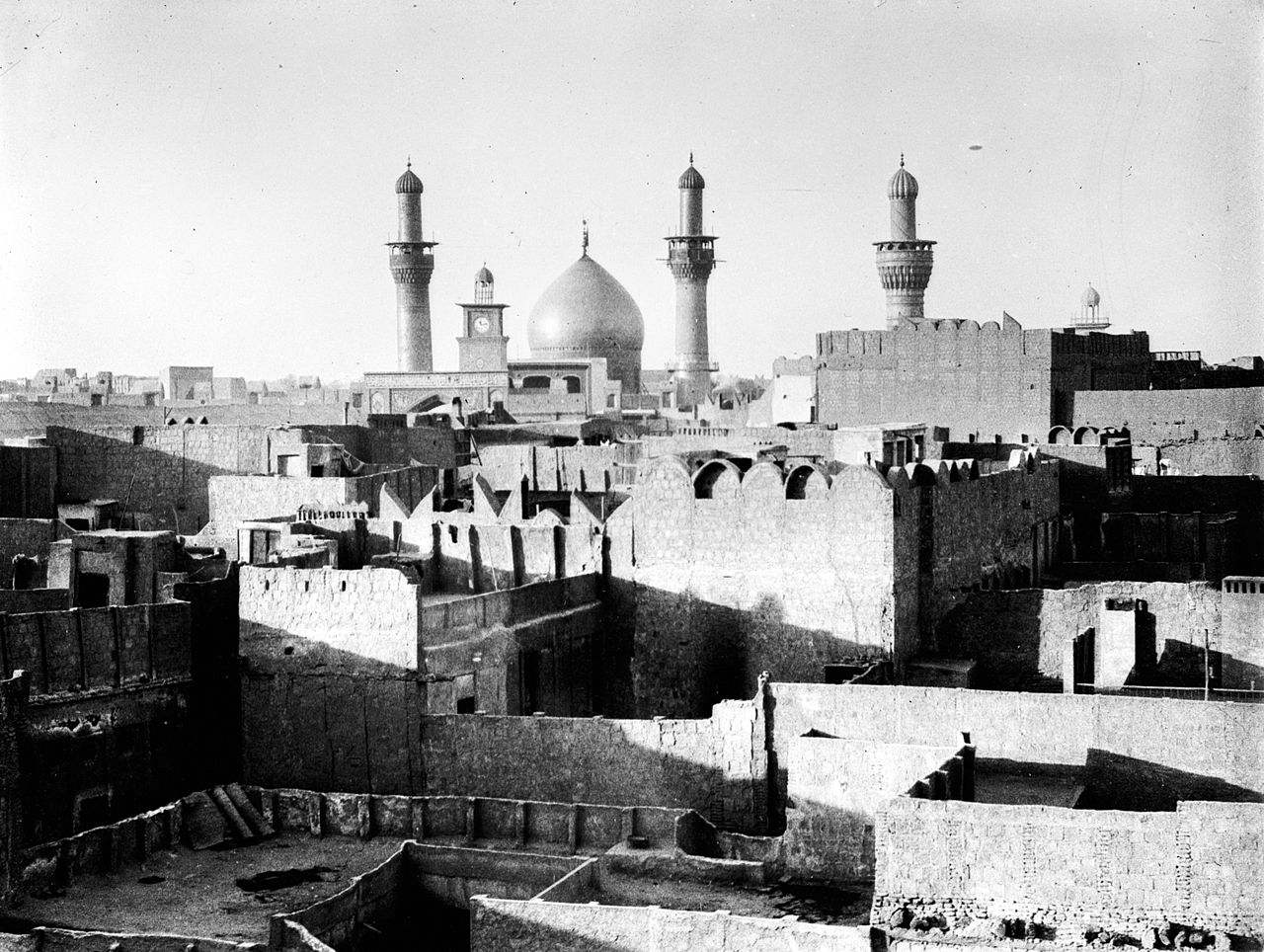
View of Karbilá in 1932, the city the Báb is about to leave in early 1842, with His uncle, returning to Shíráz and the beginning of a new life. Source: Wikimedia Commons.
Towards the end of the Báb’s year in 'Iráq, His mother, Fáṭimih Bagum, who longed to see her only Son, beseeched her brother Ḥájí Mírzá Siyyid ‘Alí to travel to 'Iráq and bring Him back.
Deeply devoted to his sister and Nephew, the uncle agreed and left for Karbilá. When he met the Báb, he told Him:
“I have come to accompany you in Your return to Shíráz.”
No matter how much Ḥájí Mírzá Siyyid ‘Alí insisted, the Báb refused saying:
“I intend to remain in the ‘Atabát for some time.”
Sometime shortly after His uncle’s arrival in Karbilá, the Báb met Mullá Ṣádiq in the courtyard of the Shrine of Imám Ḥusayn and said to him:
“My uncle has recently arrived from Shíráz, and if you wish to meet him, come to our abode.”
That very afternoon Mullá Ṣádiq went to the home of the Báb where a great many of the ‘ulamá, merchants, and other dignitaries were present, with Ḥájí Mírzá Siyyid ‘Alí sitting and conversing with the guests, and the Báb serving tea and sherbet.
Mullá Ṣádiq spoke of the Báb’s peerless qualities and His exalted character. In response, Ḥájí Mírzá Siyyid ‘Alí said:
“Even though our entire family is well known in Shíráz and its vicinity for our pious nature and goodly characters, yet this Youth shines like a most brilliant candle in our midst, and it is most evident that He is cut from a different cloth. Our one wish is for Him to undertake study of divers sciences so it would bring added honor to us. However, He refuses.”
The uncle, knowing how much his sister wanted to have her Son back in Shíráz, tried appealing to Siyyid Káẓim. He asked Ḥájí Siyyid Javád Karbalá’í, his old friend, to appeal to Siyyid Káẓim and convince the Báb to return home with him.
One day, Ḥájí Mírzá Siyyid ‘Alí went to the home of Siyyid Káẓim and explained the situation as follows:
“My Nephew lived in Búshihr for six years* before coming to the ‘Atabát. His mother has no other child beside Him and deeply longs to see Him and plans to arrange for His marriage. He has not consented to what I say, in bidding Him return to Shíráz. Therefore, I beg of you to speak with Him, that He may accompany me to Shíráz.”
At first, Siyyid Káẓim replied:
“Is it up to us to interfere? Allow us the benefit of His presence for a while longer.”
Ḥájí Mírzá Siyyid ‘Alí insisted:
“As His mother is anticipating His arrival and her approval is important as well, kindly tell Him to agree to return to Shíráz.”
Eventually, the Siyyid transmitted the message to the Báb, saying:
“If it pleases You, return to Shíráz.”
Because it was the wish of Siyyid Káẓim, the Báb consented, and left Karbilá for Shíráz to see His mother for the first time after five years.
He had spent 11 months in 'Iráq, including 8 months in the city of Karbilá.
* The Báb tells us He spent 5 years in Búshihr.
REFERENCES FOR PART II
The date range of 1835 – 1840/1841 for the Báb’s stay in Búshihr is from two excerpts in Dr. Amanat’s Resurrection and Renewal: The Making of the Bábí Movement in Iran (1844-1850):
Pages 121: “Siyyid ‘Alí Muḥammad, determined in his plans, settled allt he commercial accounts and left for the ‘Atabát sometine in 1256-1257/1840-1841 after more than five years in Búshihr.”
And page 136: “Throughout his five years in Búshihr (1250-1256/1835-1840), sometimes in the company of one of his uncles, but mostly in their absence, Sayyid ‘Alí Muḥammad participated in the family business mainly as a commercial agent.”
Balyuzi, H.M., The Báb: Herald of the Day of Days, page 39.
Terry, Peter (translator and editor), A Prophet In Modern Times by A.L.M. Nicolas. Volume I of the Babi Studies Series, (2008), pages 18-19.
‘Abdu’l-Bahá, A Traveler’s Narrative.
“In the Land of Refuge” by Ḥájí Mírzá Ḥabibu’lláh Afnán (Early to mid 1930s), cited in Childhood of the Báb, compiled by David Merrick.
Abbas Amanat, Resurrection and Renewal: The Making of the Bábí Movement in Iran (1844-1850) pages 121-124.
Fereydun Vahman (Editor),The Bab and the Babi Community of Iran (2020), Chapter 1: The Báb: A Sun in a Night Not Followed by Dawn by Fereydun Vahman.
TIME SPENT IN BÚSHIHR
The Báb Himself clearly states on pages 80-81 of Selections from the Writings of ‘the Báb that He arrived in Búshihr at the age of 15, spent five years in the city, then left for Karbilá where He spent one year before returning to Shíráz:
“Thou art aware, O My God, that since the day Thou didst call Me into being out of the water of Thy love till I reached fifteen years of age I lived in the land which witnessed My birth [Shíráz]. Then Thou didst enable Me to go to the seaport [Búshihr] where for five years I was engaged in trading with the goodly gifts of Thy realm and was occupied in that with which Thou hast favored Me through the wondrous essence of Thy loving-kindness. I proceeded therefrom to the Holy Land [Karbilá] where I sojourned for one year. Then I returned to the place of My birth.”
SOURCE: The Báb, Selections from the Writings of The Báb.
The Afnán family business of import and export
Balyuzi, H.M., The Báb: Herald of the Day of Days, page 39.
Terry, Peter (translator and editor), A Prophet In Modern Times by A.L.M. Nicolas. Volume I of the Babi Studies Series, (2008), pages 18-19.
‘Abdu’l-Bahá, A Traveler’s Narrative.
“In the Land of Refuge” by Ḥájí Mírzá Ḥabibu’lláh Afnán (Early to mid 1930s), cited in Childhood of the Báb, compiled by David Merrick.
Abbas Amanat, Resurrection and Renewal: The Making of the Bábí Movement in Iran (1844-1850) pages 121-124.
BBC Good Food: Asafoetida.
Fereydun Vahman (Editor),The Bab and the Babi Community of Iran (2020), Chapter 1: The Báb: A Sun in a Night Not Followed by Dawn by Fereydun Vahman.
REFERENCES
Nabil, The Dawn-Breakers, pages 79-80.
Balyuzi, H.M., The Báb: Herald of the Day of Days, page 39.
Terry, Peter (translator and editor), A Prophet In Modern Times by A.L.M. Nicolas. Volume I of the Babi Studies Series, (2008), pages 18-19.
“In the Land of Refuge” by Ḥájí Mírzá Ḥabibu’lláh Afnán (Early to mid 1930s), cited in Childhood of the Báb, compiled by David Merrick.
Abbas Amanat, Resurrection and Renewal: The Making of the Bábí Movement in Iran (1844-1850) page 123.
Fereydun Vahman (Editor),The Bab and the Babi Community of Iran (2020), Chapter 1: The Báb: A Sun in a Night Not Followed by Dawn by Fereydun Vahman.
Communion: Transports of delight
Nabil, The Dawn-Breakers, pages 77-79.
Terry, Peter (translator and editor), A Prophet In Modern Times by A.L.M. Nicolas. Volume I of the Babi Studies Series, (2008), pages 18-19.
The Life of the Báb from Jináb-i-Faḍil (Star of the West, Set 7, Volume 14, Number 7, page 193), cited in Childhood of the Báb, compiled by David Merrick.
The Life of the Báb from Jináb-i-Faḍil (Star of the West, Set 7, Volume 14, Number 7, page 193), cited in Childhood of the Báb, compiled by David Merrick.
Purity and incandescent devotion
Nabil, The Dawn-Breakers, pages 79-81, and note 33 in Chapter III: Comte de Gobineau’s “Les Religions et les Philosophies dans l’Asie Centrale,” page 118.
The Báb “thoroughly demolished the foundation of people’s corrupt practices”
The words of ‘Abdu’l-Bahá related directly to Ḥájí Mírzá Ḥabibu’lláh Afnán, during one of his visits to the Holy Land, found in “In the Land of Refuge” by Ḥájí Mírzá Ḥabibu’lláh Afnán (Early to mid 1930s), cited in Childhood of the Báb, compiled by David Merrick.
“The luster of the fair of face cannot be veiled”
“In the Land of Refuge” by Ḥájí Mírzá Ḥabibu’lláh Afnán (Early to mid 1930s), cited in Childhood of the Báb, compiled by David Merrick.
REVELATION: 1839: Risáliy-i-Fiqhíyyih (Treatise on Law)
In the periodized list of the Báb’s Writings below (in Persian), there is a parenthetical comment that this treatise has not survived:
https://oceanoflights.org/table/the-bab-place-and-year-fa/
Balyuzi, H.M., The Báb: Herald of the Day of Days, pages 39-40.
Terry, Peter (translator and editor), A Prophet In Modern Times by A.L.M. Nicolas. Volume I of the Babi Studies Series, (2008), page 20.
“In the Land of Refuge” by Ḥájí Mírzá Ḥabibu’lláh Afnán (Early to mid 1930s), cited in Childhood of the Báb, compiled by David Merrick.
1841 – 1842: The Báb performs the ‘Atabát
“In the Land of Refuge” by Ḥájí Mírzá Ḥabibu’lláh Afnán (Early to mid 1930s), cited in Childhood of the Báb, compiled by David Merrick.
Abbas Amanat, Resurrection and Renewal: The Making of the Bábí Movement in Iran (1844-1850), page 136
Mullá Sádiq’s first impression of the Báb
Terry, Peter (translator and editor), A Prophet In Modern Times by A.L.M. Nicolas. Volume I of the Babi Studies Series, (2008), pages 23-25.
The Life of the Báb from Jináb-i-Faḍil (Star of the West, Set 7, Volume 14, Number 7, page 193), cited in Childhood of the Báb, compiled by David Merrick.
DATE AND DURATION OF THE ‘ATABÁT
The Báb clearly states on pages 80-81 of Selections from the Writings of ‘the Báb that He arrived in Búshihr at the age of 15, spent five years in the city, then left for Karbilá where He spent one year before returning to Shíráz, which means He was in Karbilá between 1839 and 1840.
“Thou art aware, O My God, that since the day Thou didst call Me into being out of the water of Thy love till I reached fifteen years of age I lived in the land which witnessed My birth [Shíráz]. Then Thou didst enable Me to go to the seaport [Búshihr] where for five years I was engaged in trading with the goodly gifts of Thy realm and was occupied in that with which Thou hast favored Me through the wondrous essence of Thy loving-kindness. I proceeded therefrom to the Holy Land [Karbilá] where I sojourned for one year. Then I returned to the place of My birth.”
SOURCE: The Báb, Selections from the Writings of The Báb.
1753 – 1793: Shaykh Aḥmad’s calling
Nabil, The Dawn-Breakers, pages 1-4.
H.M. Balyuzi, The Báb: The Herald of the Day of Days, page 1-3.
Shoghi Effendi, God Passes By, excerpt 2.
‘Abdu’l-Bahá, Twelve Table Talks given by ‘Abdu’l-Bahá in ‘Akká.
1817 – 1821: Shaykh Aḥmad visits Persia
Nabil, The Dawn-Breakers, page 16.
H.M. Balyuzi, The Báb: The Herald of the Day of Days, pages 2-3
1821 – 1826: Shaykh Aḥmad’s return to Karbilá
Nabíl, The Dawn-Breakers, pages 25-27 and page 30.
H.M. Balyuzi, The Báb: The Herald of the Day of Days, pages 3-4.
1826 – 1841: Siyyid Káẓim continues his master’s work
Nabíl, The Dawn-Breakers, pages 25-27 and page 30.
H.M. Balyuzi, The Báb: The Herald of the Day of Days, pages 3-4.
The Báb meets Siyyid Káẓim-i-Rashtí in Karbilá
Nabíl, The Dawn-Breakers, pages 25-27 and page 30.
Three days later: The Báb is present during a lecture by Siyyid Káẓim
Nabíl, The Dawn-Breakers, pages 27-30.
“In the Land of Refuge” by Ḥájí Mírzá Ḥabibu’lláh Afnán (Early to mid 1930s), cited in Childhood of the Báb, compiled by David Merrick.
The Báb’s uncle arrives in Karbilá
In the Land of Refuge” by Ḥájí Mírzá Ḥabibu’lláh Afnán (Early to mid 1930s), cited in Childhood of the Báb, compiled by David Merrick.
Khándán Afnán Fayzí quoted by Mázandarání in Táríkh Zuhúru’l-Ḥaqq, Volume 3, pages 132–33 and cited in Childhood of the Báb, compiled by David Merrick.
NOTES
The Báb tells us Himself that He lived in Búshihr for five years.
 1835 – 1840: In Búshihr/1841
1835 – 1840: In Búshihr/1841
